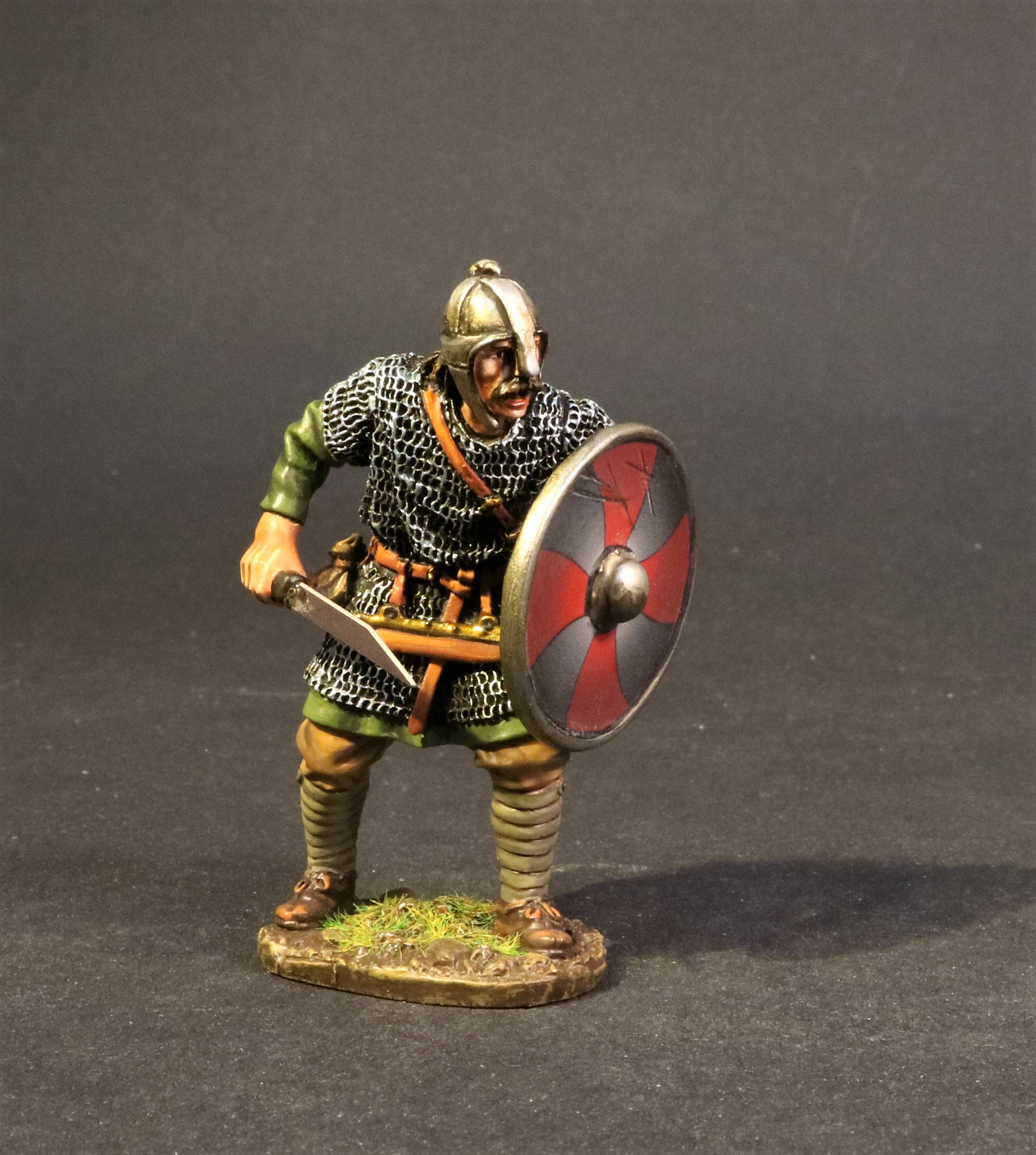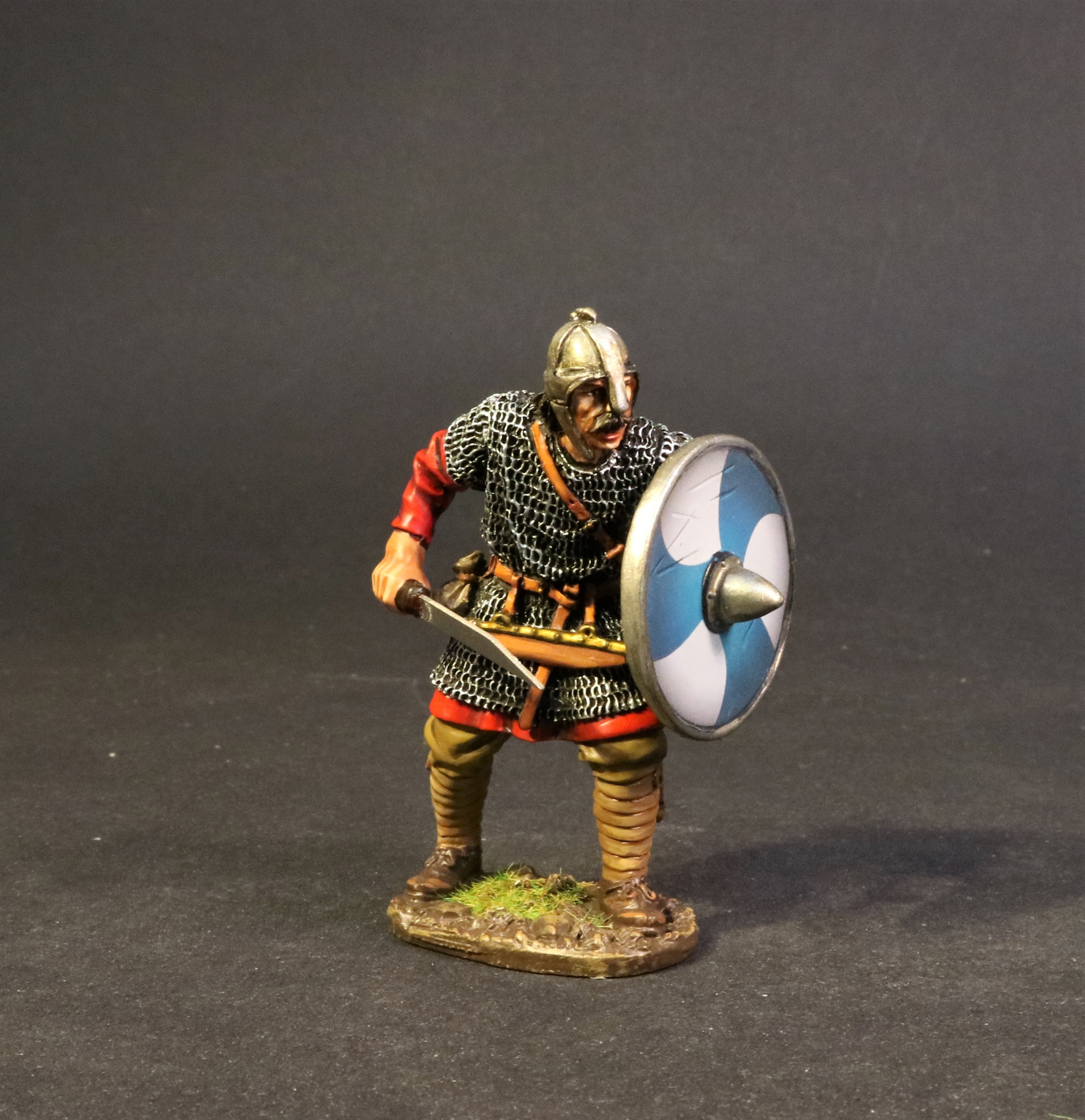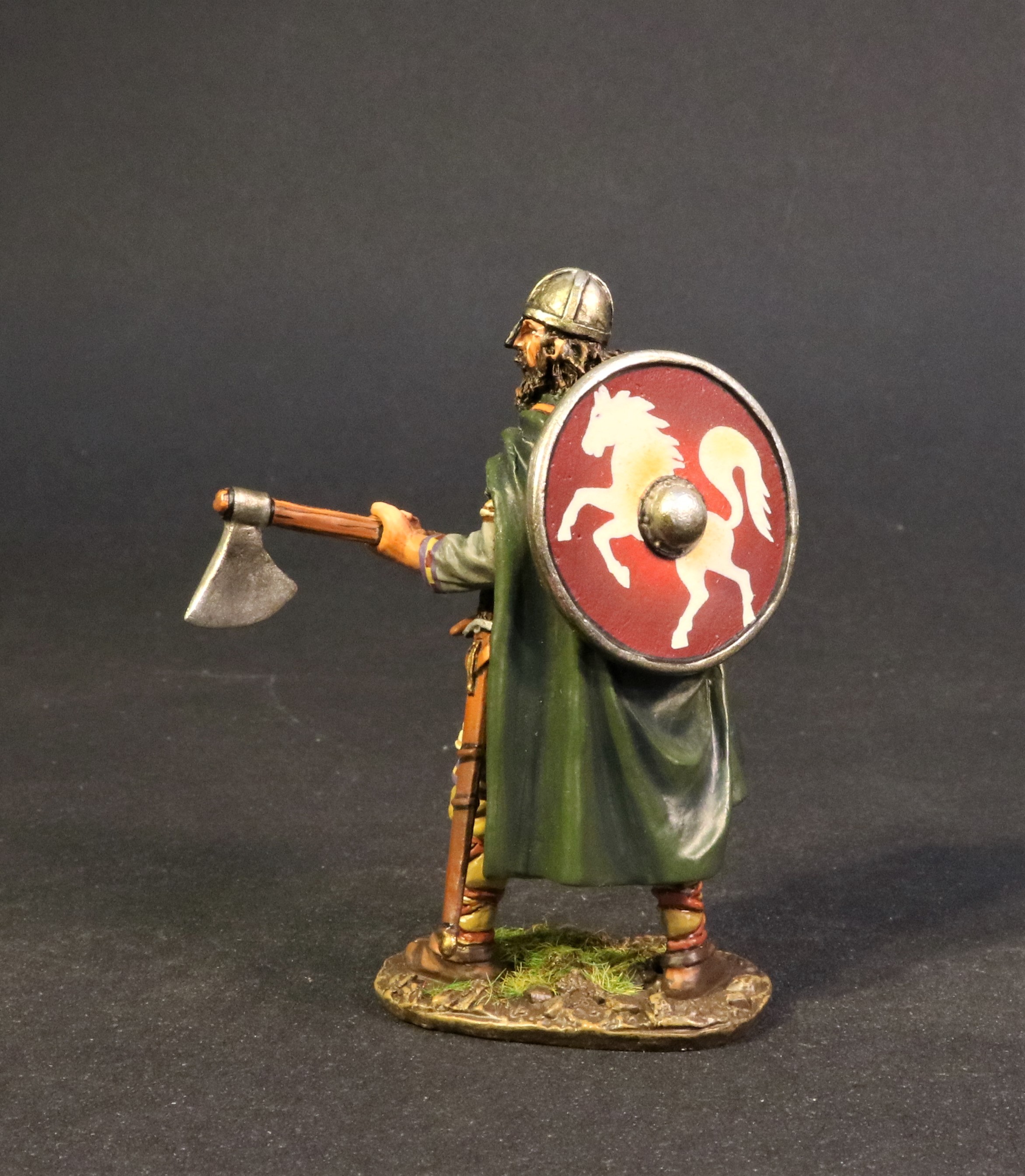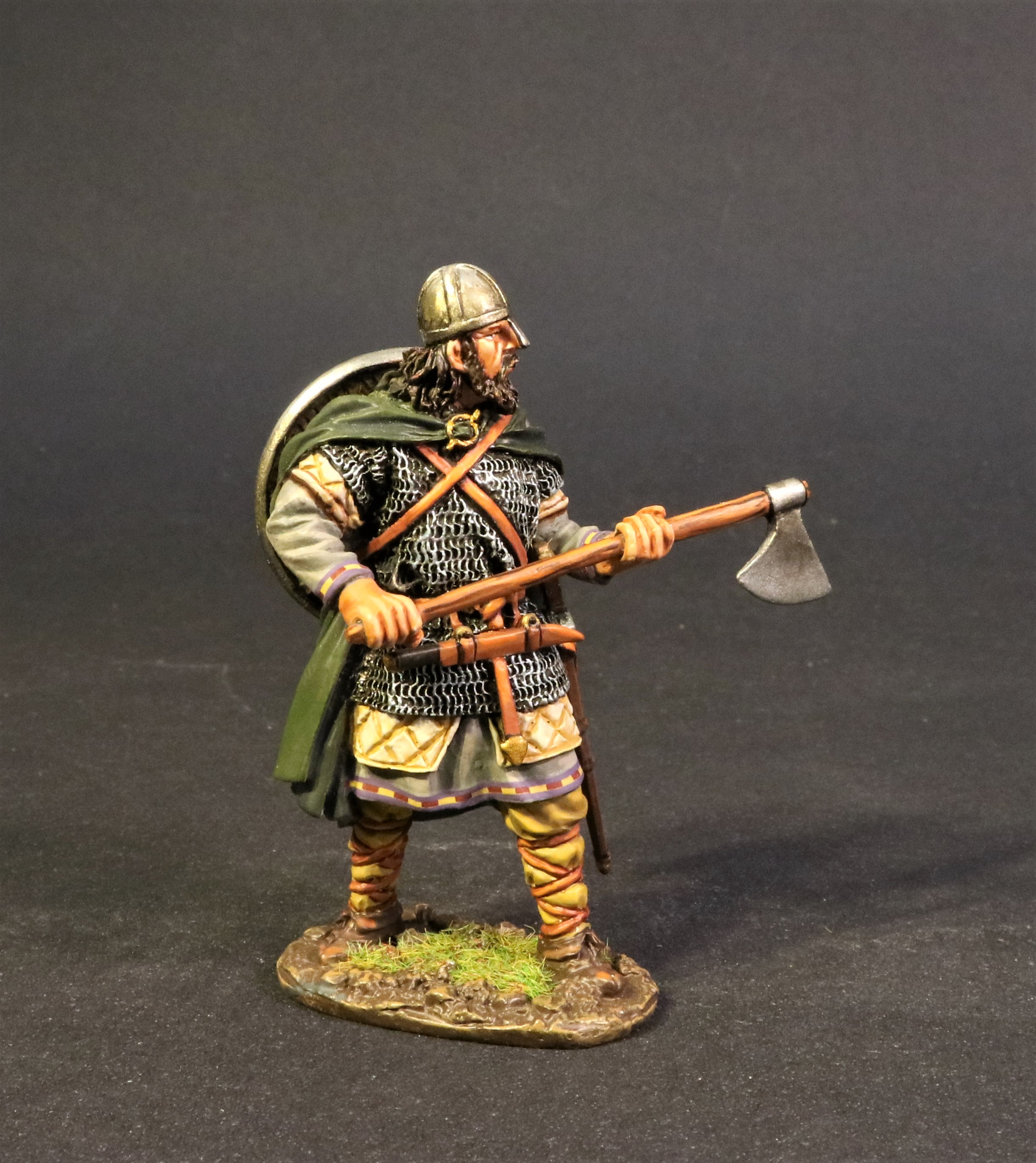Anglo-Saxon Military Organization
Nov 6th 2019
Trains and Toy Soldiers has new products from John Jenkins Designs, including figurines from the Age of Arthur, Anglo Saxon / Danes. We're looking at Anglo-Saxon military organization and fyrdsmen this week, with help from Regia Anglorum.
The military organization of the Anglo-Saxons is a difficult subject. It is impossible to give precise details of developments, primarily because the Saxons did not need to define their military organization for themselves; it was part of the life of every able bodied man. In the beginning there were simply war bands, small bodies of semi-professional or solely professional warriors led by their chosen chiefs. Loyalty to a chief was the greatest virtue, and warriors sought out a leader who would further their military career. If a chief or king died in battle his men would die avenging him, although a few might survive after being struck down and left for dead. It was considered dishonorable to leave the battlefield on which your lord had been slain, and it was not unknown for those few who did survive to be executed by their lord's successor for their disloyalty and lack of zeal (Regia).
From the beginning of the, 9th century the English kingdoms were under attack by other bands of professional warriors - the Vikings. Some form of levy existed to deal with these raids. The king had an 'elite' corps of ðegns or thegns, who made up the king's personal 'Hearth Troop,' or hirð. These ðegns had to become 'professional' warriors, not because they were a trained elite, but because their position depended on it. The onus for local defense must have fallen on the eorls. It was their job to summon the fyrd in emergencies, which they or their ðegns could have done reasonably quickly in the areas affected by the raids (Regia).

“The personal followers of the leaders, the thegns and numbers of hired mercenaries (often other Scandinavians), formed the spearhead of any force. From the early 9th century this was supported by what was later called the fyrd (literally meaning 'journey', and it came to have the special meaning of 'armed expedition or force'). The fyrd was raised by selective recruitment, rather than a general levy, usually drawing one man for every five hides of land. Most of the fyrd would therefore have been thegns, although there are records of 'free men' serving in the fyrd at Hastings. However, the actual obligation was upon each ðegn to provide a man, usually himself, for fyrd service. Since a ðegn would usually have five hides we have the figure of one man from five hides, but the obligation was upon the man, not the land. Since the obligation was on the man, and not the land, some ðegns could own less than the usual five hides (perhaps because a father had split his estate between several sons) . Those poor ðegns who had only a hide or two were still obliged to provide a fyrdman - fyrd service is almost never left out of charters for land-grants” (Regia).
The fyrd could contain members of the upper peasantry, the Ceorls. In these cases the men involved combined to dispatch one of their number (usually the same man) whenever the fyrd was summoned. The representative would ensure that he was well equipped, and ambition and experience would soon create worthy warriors. The usual armament for a fyrdsman laid out in contemporary documents was a spear, shield, helm, byrnie and a palfrey (riding horse). Often a sword was included in the list. Although a horse is mentioned it was only to allow the fyrd to be specifically mobile. In battle the warriors would dismount and fight on foot (Regia).
If the men summoned for the fyrd did not turn up there were severe penalties:
'When the king goes against an enemy, should anyone summoned by his edict remain, if he is a man so free that he has his soke and sake, and can go with his land to whomever he pleases [i.e. king's ðegns and eoldermen], he is in the king's mercy for all of his land. But if the free man of some other lord has stayed away from the host and his lord has led another in his place, he will pay 40s. to his lord who received the summons. But if nobody at all has gone in his place, he himself shall pay his lord 40s., but his lord shall pay the entire amount to the king.'

The towns were also assessed in hides, and the inhabitants were required to send representatives. In some instances the towns could commute their service by paying the crown a sum necessary to hire a replacement. Anglo-Saxon England was still developing a cash economy and most workers were paid in kind, the markets where wages could be spent did not properly exist. For example, Ely Abbey acquitted its lands of 'fyrdinge' through the payment of 10,000 eels a year to the king. Other scattered references in The Doomsday Book to lands that 'aided the king's expeditions' imply that pre-Conquest lesser landowners made similar arrangements with the crown (Regia).
“A fyrdsman served because his land grant said he had to, and failure to serve led to a fine. The money paid would have gone to the king or eorl to provide food for mercenaries, not wages. The king's obligation to provide food only began after the men had served their full term. Each hide was charged four shillings (in kind) towards the maintenance of the selected representative, twenty shillings for a five hide unit, and as sixty to ninety days was the customary period of service, this meant a wage of three to four pence per day. This is roughly comparable to the wages of a knight post-Conquest, demonstrating that the Fyrd was indeed a select body of men and not a rag-bag collection of farmers with agricultural implements for weapons.
In later years there was also an alternative obligation to supply a warrior seaman for the fleet. For this reason the five hide units were combined in some regions into districts of 300 (or 310) hides, which were called ship sokes. These were required to produce sixty sokesmen (warrior seamen), and also pay for the construction and maintenance of a warship which the men manned. Some ports, particularly those that later became the Cinque Ports, were also required to supply smaller ships to augment the fleet. An example of this has been found in Denmark where taxes of just this nature reflected their own need to protect their coasts and ports. In Roskilde fjord, a barrier of four burned and scuttled vessels in an old shipping lane were excavated in the mid 1960s. One of the wrecks turned out to be a midsized warship, made it seems, from the hull of an older ship with ash additions to transform it into a warship, probably for the port of Roskilde.
In peace time the ðegns (possibly the entire fyrd) had to serve one month in three in rotation so there was always a sizeable force on hand. They were not only warriors but also acted as a police force to catch criminals, in which their mounted mobility helped, and deal with the widespread problem of sporadic banditry. In the Welsh and Scottish Marches special conditions existed and the levies might have to serve for fifteen days and accompany expeditions beyond their shire boundaries on forays into Wales and Scotland where their knowledge of the border areas was invaluable” (Regia).
By the beginning of the 11th century all the ðegns usually held estates of five hides or more, and so by this date they probably constituted the bulk of the fyrd. At the beginning of the century, there is the first mention of the elite body of warriors known as Huscarles. It is thought that these were introduced after Svein Forkbeard's conquest of England in 1014, and probably raised by Cnut in 1033, although it is highly possible they had existed at the time of Swein's conquest. Completely professional soldiers, they had their own rules of conduct, living at the king's court and receiving his pay, as opposed to gifts or kind. They formed a small but efficient and highly organized standing army, both well-disciplined and heavily armed. Cnut, we are told, required his Huscarles to possess 'splendid armor' and a double-edged sword with a gold-inlaid hilt, as a condition of acceptance into his military entourage. Although a primarily a footsoldier, a huscarl would also have owned a horse to carry him to battle and in pursuit of the defeated enemy, and a variety of weapons, including a mail-shirt, helmet, shield, javelin, and, of course, the 'massive and bloodthirsty two-handed axe' that characterized him. Despite being paid in coin their obligation to serve in arms arose from the lordship bond rather than the cash inducement. The rewards were incidental to the service they rendered (Regia).

Huscarls served their royal lords in peace as well as war. The huscarls were retained by Edward the Confessor and Harold Godwinsson, and during the reign of the former they appeared to have been recruited by the great eorls as well. Tostig's English and Danish retainers are referred to as huscarls by the Anglo-Saxon Chronicle, but the word may have become a general term describing all landless soldiers as opposed to ðegns who were warriors and land owners under the king (Regia).
“There are other references to mercenaries in the pay of the king or eorls who were clearly not huscarls. The lithsmen and butsecarles were skilled seamen who also fought on land, more like Marines today, and often seem to have sided with the highest bidder. Not that sea battles were anything like we tend to think of them today. Enemy ships were chased to ground, or the shore in these cases to engage the troops, or the boats were very rarely tied together as a raft and drifted into each other as a platform to fight a 'land' battle on. These and other paid warriors provided the late Saxon kings with a highly trained nucleus supported by the eorls and their war bands, and the ðegns of the fyrd” (Regia).
By the mid 11th century the royal huscarls probably numbered about 3,000. Eorl Tostig lost two hundred of his own huscarls during the Northumbrian revolt in 1065 - as some of his huscarls survived and escaped a figure of around 250 - 300 huscarls seems reasonable for a powerful eorl.
A national land-fyrd would have consisted of the following components: the forces of the eolderdoms, shires, hundreds (private and royal), private sokes and various companies of stipendary troops, and personal retainers brought by the king and his great magnates. Similarly, a scip-fyrd would have included royal warships manned by the king's butescarles and lithsmen, perhaps the private ships of his eorls, vessels supplied and manned by the ship-sokes, and by 1066, the ships owed in lieu of other royal renders by the boroughs that were to become known as the Cinque Ports (Regia).
The evidence for the shire as a tactical unit is overwhelming. Below the shire level, however, matters become less clear. Much is vague about the lesser tactical units of the fyrd, but it seems certain that just as the shires were subdivided into hundreds for judicial and administrative purposes, so the shire levies of the fyrd consisted of hundred contingents. Using the five hide rule this would give basic units of 20 men. Interestingly enough, in Alfred's day, 36 men and over constituted an Army, with less than that a warband, so maybe these figures are a little low. Although with the variance in size of a hundred, and the variance in the number of hides required to produce a warrior, a unit of 15 - 25 men would seem reasonable. Each unit would usually be led by its 'hundred eolder' (Regia). Although many of the fyrd owned land, they were primarily warriors who farmed when not serving, rather than farmers who fought.
At Hastings, the Saxon army, with its elite force weakened through achieving victory at Stamford Bridge, and short of the quota of men from the fyrd, successfully withstood the Norman army in a battle which lasted considerably longer than was typical for the period from dawn until dusk. At its full strength it could probably have held its own against any army in western Christendom. Its value was certainly not underestimated by its conquerors, who not only adopted the broad-axe, but also perpetuated the fyrd system (Regia).

References & Further Reading
Regia Anglorum. Anglo-Saxon Military Organisation. https://regia.org/research/warfare/saxons2.htm
Regia Anglorum. The Anglo-Saxon Fyrd c. 400-878 A.D. https://regia.org/research/warfare/fyrd1.htm
Regia Anglorum. The Anglo-Saxon Fyrd 878-1066 A.D. https://regia.org/research/warfare/fyrd2.htm
Wikipedia. Anglo-Saxon Military Organization.
Wikipedia. History of Anglo-Saxon England.
Wikipedia. Fyrd.

